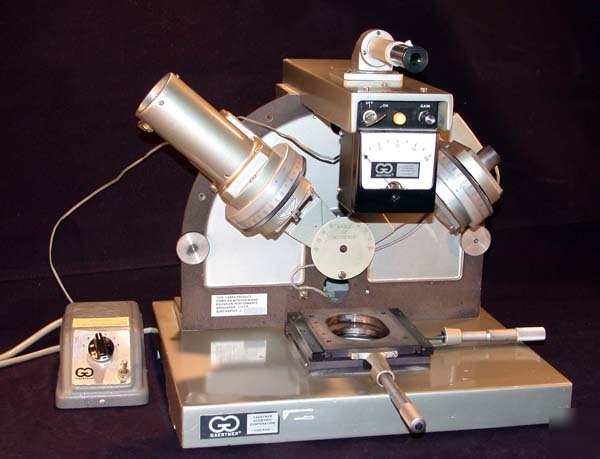georgia-market.com moderated newsgroup and market bazzar > Dalton
> Gaertner L117 variable angle manual ellipsometer
Gaertner L117 variable angle manual ellipsometer
Variable Angle Manual Ellipsometer
In excellent cosmetic condition.
Powers up. meter responds, light works, XY-stage moves freely. Optics are clear.
Variable angle traditional manual nulling ellipsometer.
Measurements are made in minutes by manually rotating the polarizer and analyzer drums.
Please click on the below thumbnails to enlarge them.
DSCN0734DSCN0735DSCN0740DSCN0748
DSCN0738DSCN0744DSCN0745DSCN0746DSCN0739
The Gaertner Scientific Corporation began as a small scientific shop established by William Gaertner in 1896 on Chicago’s Southside. The company, originally known as Wm. Gaertner & Co., manufactured astronomical and astrophysical measuring instruments for the Yerkes Observatory and interferometers for Professors Michelson and Stratton at the University of Chicago.
Since it’s founding, the organization has been engaged continuously in the design and manufacture of a variety of precision scientific instruments intended for use in research, industrial, educational and government laboratories and shops. Their main products are ellipsometers for thin film measurement, measuring microscopes for dimensional measurements as well as other specialized optical instruments.
Ellipsometry is a non-contacting, nondestructive technique for the measurement of surfaces and very thin films on surfaces using elliptically polarized light. No other measuring technique is as direct or inherently as precise as ellipsometry. Quality ellipsometers can detect film and surface conditions of under an Angstrom thick.
Ellipsometry is superior to alternate methods of thin film measurement such as reflectometry because two parameters (DELTA and PSI) instead of one (intensity) are independently determined in any single measurement. This fact permits the film refractive index to be measured in addition to the film thickness. Two independent parameters also place tighter constraints on models representing more complicated films. In addition, ellipsometric measurements are insensitive to intensity fluctuations of the source, temperature drifts of electronic components, and macroscopic roughness which can be a serious problem in reflectometry but not in ellipsometry, for which absolute intensity measurements are not required.
Transparent films from under one angstrom up to several microns and absorbing films less than 500 angstroms thick can be measured ellipsometrically. The surface upon which the film is measured can be a semiconductor, dielectric or metal. The film can be transparent or absorbing in a medium of transparent solid, liquid, gas or vacuum. The measuring polarized light can range from the ultra violet to the Infrared.
Ellipsometers are used in a wide variety of surface and thin film studies - in microelectronics, solar cells, optical disks, X-ray films, biological layers and more recently, in superconductivity. Here are a few examples:
Measurements of Silicon wafers in the Semiconductor industry
Measurements of dielectric and oxide films on metals and semiconductors
Detection and measurement of contamination on metal and glass
Monitoring vapor deposition of organic and inorganic films
Measurement of reflective and non-reflective coatings on glass
Measurement of anodized and very thin painted layers
Detection of contamination and impurities on surfaces and in thin films
Blood coagulation and immunological reactions
Crystal and mineral surface analysis
Chemisorption on metal and other surfaces
Measurement of air flow birefringence
Temperature dependence of film thickness of liquid helium films
Antibody-antigen reaction in immunology
Boundary roughness effect of layered systems
Electron hole plasma generation Ge
AI2O3 amorphous film growth and crystal island development
Sub-mono-layer molecular film
Pyrolytic film characterization
Ellipsometry is based on the polarization of a light beam being altered on reflection from a bare or film coated surface. An elliptically polarized light beam is defined by the angular position of the ellipse (azimuth), its shape (ellipticity), and the sense of rotation of the light vector. Two parameters determine the state of polarization; these are the amplitude ratio, PSI and the phase difference DELTA.
The ellipsometer is used to measure PSI and DELTA, and thus with the known values of PSI, and DELTA the film thickness and index can be calculated. Since the equation contains complex quantities, its solution is done by computer.
While a number of different ellipsometry methods exist for obtaining PSI and DELTA the most common are the nulling, rotating analyzer, and exclusive to Gaertner the StokesMeterâ„¢ method.
The oldest measurement method is manual nulling which requires rotating the polarizer and analyzer circles until the reflected beam from the sample is extinguished. When extinction is achieved (takes a few minutes), the polarizer and analyzer circles are read. These readings are then converted into film thickness and film refractive index by using tables, graphs, or personal computers. Our model L117F an example of a manual nulling type ellipsometer.
Measurement by automatic ellipsometers was introduced with the advent of the personal computer. Typically a rotating analyzer encodes the reflected beam intensity in less than one second, then a A/D converter digitizes the intensity and sends the data to a computer where the data is modeled for film thickness and film refractive index. Our model L2W16ir633.1500 is an example of a rotating analyzer ellipsometer.
Newer methods such as the StokesMeterâ„¢ polarimeter measure by reflecting the measuring light beam from 4 stationary detectors. The measuring laser light beam can be described by the normalized stokes parameters [1,S1,S2,S3] which in turn yield PSI and DELTA. Our model L115S is an example of a Stokes Ellipsometer.
To see all photos of this item, please click here.
and other Important Information, please visit the
We are committed to 100% recycling and minimizing our waste. We use 99% recycled or previously used packaging products and try to minimize our environmental impact. Please reduce, re-use and recycle and save our planet for future generations.

